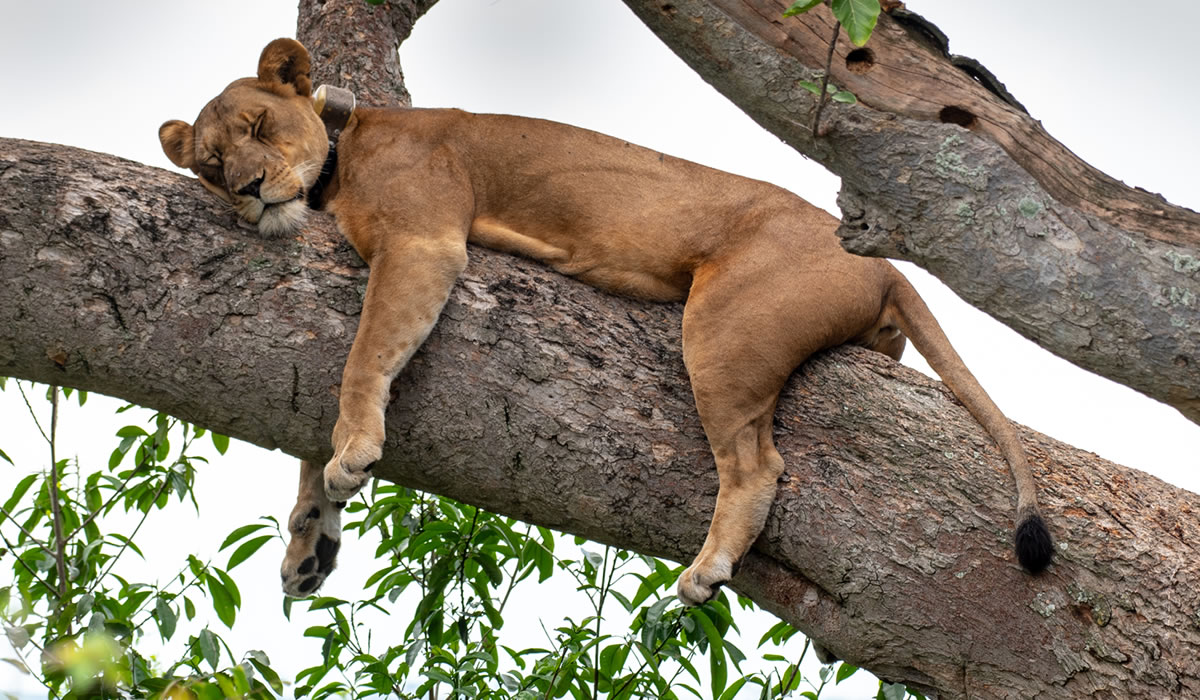Queen Elizabeth National Park (QENP) is Uganda’s most visited and iconic safari destination, known for its stunning landscapes, abundant wildlife, and rich cultural heritage. Located in western Uganda, spanning the districts of Kasese, Kamwenge, Rubirizi, and Rukungiri, the park covers an area of about 1,978 square kilometers. From the shimmering waters of Lake Edward and Lake George to the rolling savannah plains, volcanic craters, and dense forests, QENP offers a diverse range of habitats that support an extraordinary variety of wildlife. The park is a dream destination for nature enthusiasts, bird watchers, photographers, and adventure travelers seeking an authentic African safari experience.

Diverse Landscapes and Ecosystems
One of Queen Elizabeth National Park’s most remarkable features is its diversity of landscapes. The park encompasses the savannah grasslands of the Kasenyi Plains, home to large herds of Uganda kob and topi; the crater lakes region, with 45 volcanic craters filled with water and surrounded by lush forests; the Ishasha sector, famous for tree-climbing lions; and the scenic Rwenzori Mountains, which provide a dramatic backdrop to the park’s western border.
The Kazinga Channel, a natural waterway connecting Lake George and Lake Edward, is a vital part of the park’s ecosystem and a haven for wildlife. Hippos, crocodiles, elephants, and buffaloes gather along its banks, and countless bird species, including the rare shoebill stork, make this area a paradise for birdwatchers. The channel also supports fishing communities and provides opportunities for scenic boat cruises that allow visitors to enjoy wildlife from the water.
Wildlife in Queen Elizabeth National Park
Queen Elizabeth National Park is home to over 95 mammal species and more than 600 bird species, making it one of the most biodiverse parks in Uganda. Visitors can expect to encounter elephants, lions, leopards, buffaloes, hippos, crocodiles, waterbucks, bushbucks, Uganda kobs, topis, warthogs, hyenas, and a variety of primates including chimpanzees in Kyambura Gorge.
The Ishasha sector in the south of the park is particularly famous for its tree-climbing lions, a rare phenomenon that attracts wildlife enthusiasts from around the world. These lions are often found resting on the branches of fig and acacia trees, creating an unforgettable safari sight. The Kasenyi Plains, on the other hand, provide excellent opportunities for spotting large herbivore herds and predators in open savannah landscapes, while the crater lakes and forested areas offer encounters with smaller mammals, primates, and an abundance of birdlife.
For bird lovers, Queen Elizabeth National Park is a paradise. Over 600 species have been recorded, including the African fish eagle, herons, kingfishers, hammerkops, and the elusive shoebill stork. Migratory birds also visit the park seasonally, adding to the diversity. The Kazinga Channel is particularly famous for its concentration of birds, making it a top destination for birdwatching safaris.
Activities in Queen Elizabeth National Park
Visitors to Queen Elizabeth National Park have a wide range of activities to choose from, catering to all types of travelers. Game drives are the most popular way to explore the park, especially in the Kasenyi Plains, Ishasha sector, and along the main park roads. Early morning and late afternoon drives offer the best chances of spotting predators, herds of elephants, and other wildlife in action. Experienced guides provide insights into animal behavior, the ecosystem, and the park’s conservation efforts.
Boat cruises along the Kazinga Channel are a highlight of any visit to QENP. These cruises allow travelers to observe large pods of hippos, crocodiles basking on the banks, and elephants drinking from the water’s edge. Birdwatching from the boat is equally rewarding, with opportunities to spot rare and colorful species up close. Sunset cruises along the channel are particularly popular, providing beautiful photo opportunities and serene experiences.
Kyambura Gorge, often referred to as the “Valley of Apes,” offers guided chimpanzee trekking. Visitors can follow habituated chimpanzees in their natural habitat, observing their social behaviors, feeding, and play. The forested gorge also hosts other primates, small mammals, and a variety of birds, making the trek both adventurous and educational.
Hiking is another popular activity, particularly in the crater lakes area and the foothills of the Rwenzori Mountains. Trails offer breathtaking views, scenic landscapes, and opportunities to explore the park on foot. The crater lakes themselves, scattered across the Kasese and Rubirizi districts, are ideal for nature walks, photography, and birdwatching.
Cultural experiences are also available for travelers interested in local communities. Visitors can interact with the Bakonzo, Batooro, and other communities surrounding the park, learn about their traditions, and visit local villages. These experiences provide insight into the cultural heritage of the region while supporting sustainable tourism initiatives.
Accommodation in Queen Elizabeth National Park
Queen Elizabeth National Park caters to a wide range of travelers, from luxury safari seekers to budget-conscious adventurers. Luxury lodges such as Mweya Safari Lodge, Paraa Safari Lodge, and Ishasha Wilderness Camp provide high-end amenities, comfortable rooms, exquisite dining, and prime locations near wildlife hotspots. Mid-range options like Simba Safari Camp, Enganzi Game Lodge, and Crater Safari Lodge offer quality accommodation with good service and convenient access to main park attractions. Budget-friendly options include local campsites, guesthouses, and hostels, which provide affordable stays for backpackers and small groups.
Accommodation is often strategically located to offer stunning views of lakes, savannah plains, or wildlife corridors. Many lodges also organize safari activities, ensuring guests can enjoy guided game drives, boat cruises, and cultural experiences without hassle.
Best Time to Visit Queen Elizabeth National Park
The park is accessible throughout the year, but the best time for wildlife viewing is during the dry seasons, from December to February and June to September. During these months, the grass is shorter, water sources are limited, and animals gather in predictable areas, making game spotting easier. The wet seasons, from March to May and October to November, bring lush greenery, spectacular scenery, and excellent opportunities for birdwatching, although some roads may become more challenging to navigate.
Despite seasonal variations, Queen Elizabeth National Park offers incredible experiences year-round. Visitors should plan their trips in advance, especially if they intend to trek chimpanzees, as permits are limited and highly sought after.
Getting to Queen Elizabeth National Park
Queen Elizabeth National Park is located approximately 400 kilometers southwest of Kampala, Uganda’s capital city. Travelers can reach the park by road, which typically takes around 8 to 10 hours depending on traffic and road conditions. The main access points are the Kasenyi Gate, Ishasha Gate, and Mweya Gate. Road trips from Kampala often pass through scenic countryside, tea plantations, and small towns, adding to the travel experience.
For quicker access, chartered flights are available from Entebbe International Airport or Kajjansi Airfield to Mweya, Kasese, or Ishasha airstrips. Domestic flights provide a convenient and scenic option for travelers who prefer to save time and enjoy aerial views of the park.
Conservation and Community Engagement
Queen Elizabeth National Park is managed by the Uganda Wildlife Authority, which focuses on protecting wildlife, preserving ecosystems, and promoting sustainable tourism. Anti-poaching measures, habitat restoration, and community conservation initiatives are central to the park’s management strategy. Local communities benefit from tourism through employment opportunities, cultural programs, and revenue-sharing initiatives that support education, healthcare, and infrastructure development.
Tourists are encouraged to support responsible tourism practices, such as staying at eco-friendly lodges, purchasing local crafts, and respecting wildlife. These efforts help ensure that Queen Elizabeth National Park continues to thrive as a sustainable destination for generations to come.
Queen Elizabeth National Park is one of Uganda’s crown jewels, offering a perfect combination of breathtaking landscapes, diverse wildlife, and immersive safari experiences. From the tree-climbing lions of Ishasha to the hippo-filled Kazinga Channel, from chimpanzees in Kyambura Gorge to birdwatching among crater lakes, the park delivers unforgettable encounters with nature. Its mix of luxury lodges, budget accommodations, and adventure activities makes it accessible to all types of travelers.
For anyone seeking an authentic African safari, Queen Elizabeth National Park provides a comprehensive and enriching experience. The park’s natural beauty, rich biodiversity, and cultural heritage make it a must-visit destination, promising memories that will last a lifetime.

